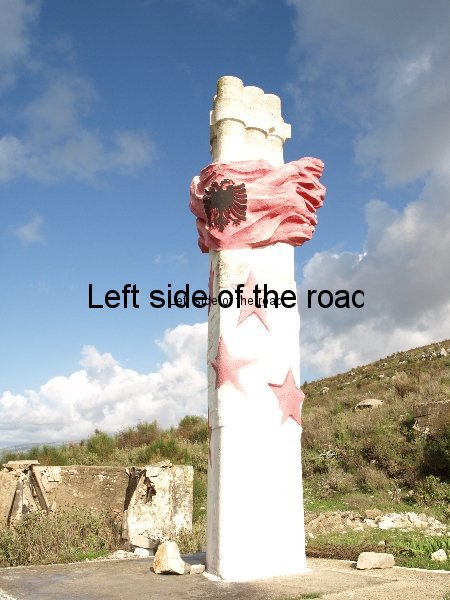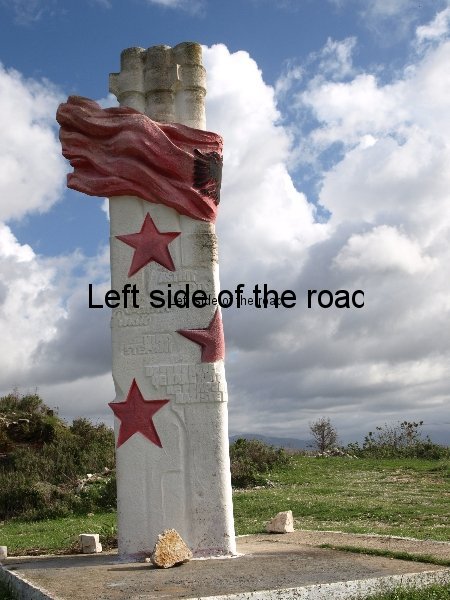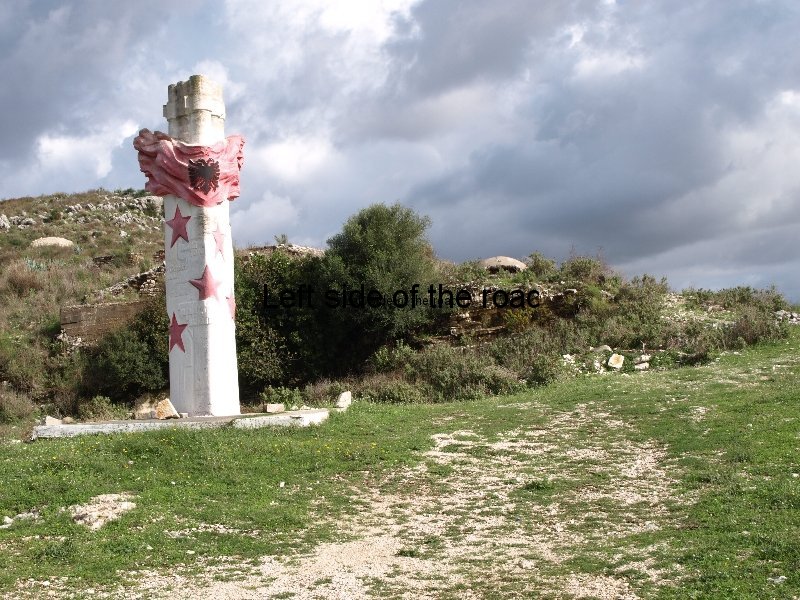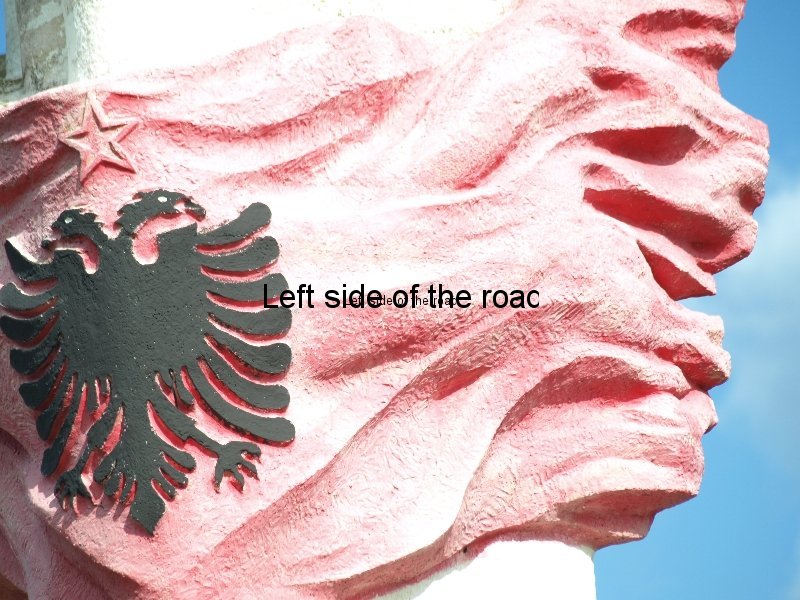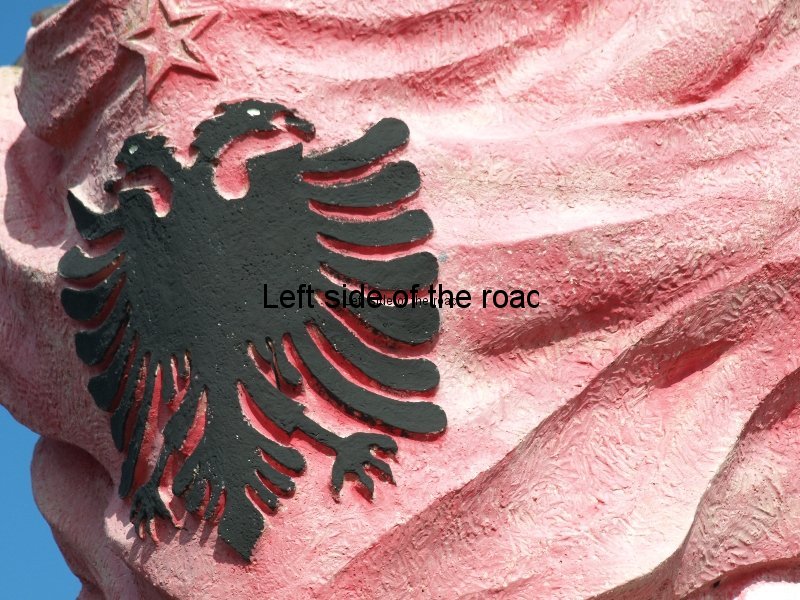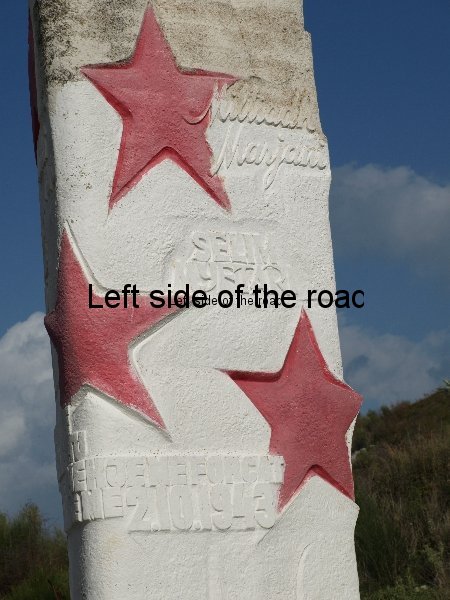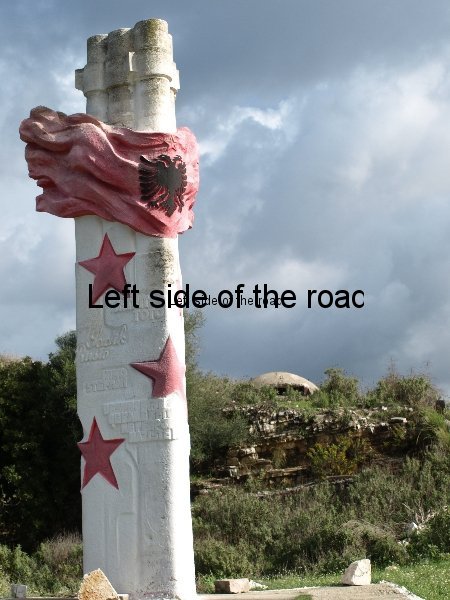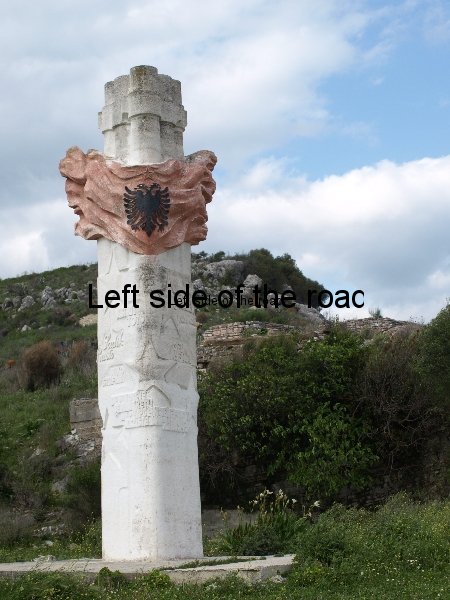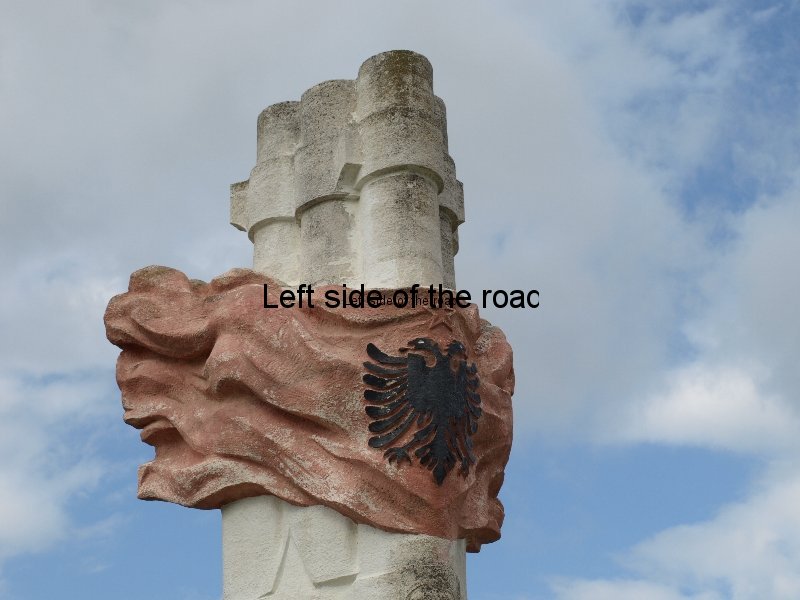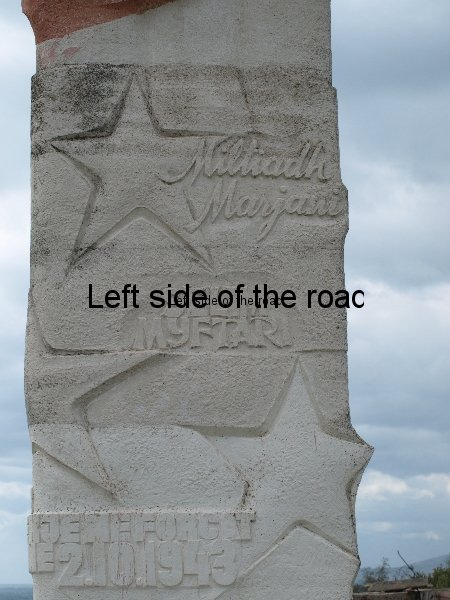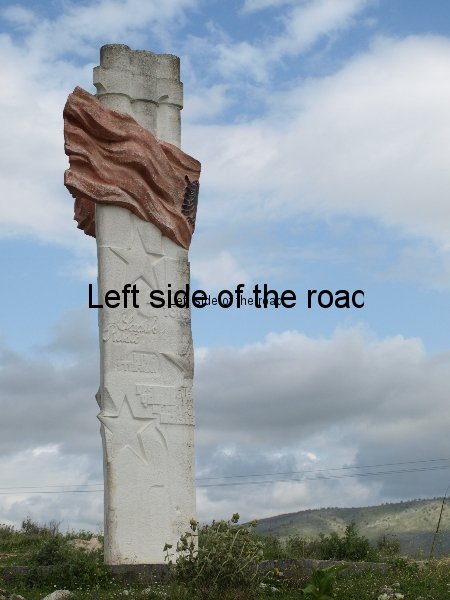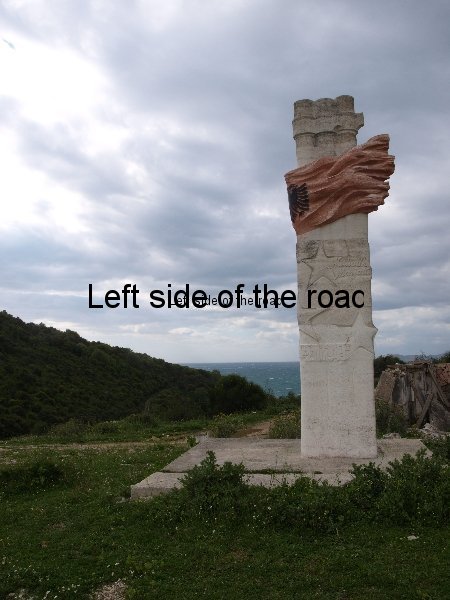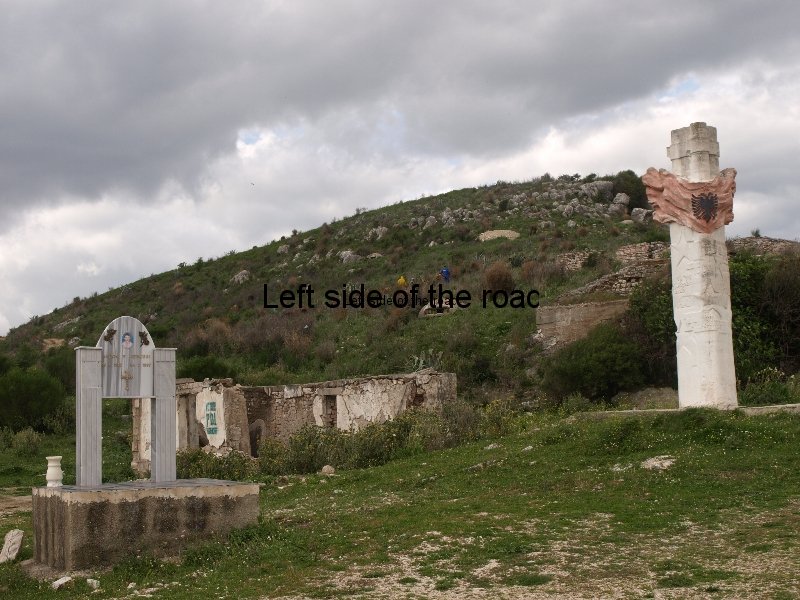
The complete mural
Death to Fascism Mural in the National Historical Museum, Tirana
The mural that covers the whole of one wall in the room of the National Historical Museum in Tirana that’s devoted to the War of Liberation against the invading fascists of 1939 to 1944 is one of the few which can still be appreciated at leisure by any visitor. There’s another which can be seen, but not fully understood, as it’s in a room which is undergoing renovation at the moment. Whether it will be covered in some way as part of this renovation is unknown – but hopefully not.
Since the end of the 1990s, when relative stability was regained in the country, various Albanian governments of various colours have sought to slowly but surely eradicate the period of the construction of Socialism, from 1944 to 1990, as if it had never existed. Those of the neo-fascist right (some of whom were even members of the Party of Labour of Albania for many years but changed their allegiance once the opportunity presented itself – therefore justifying the idea of Joseph Stalin that the Party constantly needs to purge itself of opportunist elements) want the past eradicated so that their names cannot be associated with those actions and tactics which they now deny.
Those of the opportunist now social-democratic ‘left’ don’t want to show themselves in their true colours, offering ‘easy’ options to difficult problems and denying that the efforts to construct a wholly new world order had any value whatsoever. They look for comfort in the ‘tinkering’ of the system as they are totally inadequate in the task of substantially changing society forever. Efforts by those who have tried to do so in the past – whatever the failings and the mistakes that might have been made – only show them up for the weak and cowardly opportunists that they are.
Capitalism has, in the last hundred years, constantly criticised Socialist states of ‘re-writing history’. This is not the place to argue the truth of such accusations but what is certain is that this ‘holier than thou’ approach is mainly used as a smokescreen for the oppressive and exploitative system to justify the way it has, still does and will until the days it is destroyed forever, interpreted history in a manner which portrays capitalism and imperialism as the only possible system that can exist throughout the world – despite the innumerable crimes it has, still does and will commit in the future.
But back to the mural.
This one depicts images from the war against German Nazism. It does not pretend to be a view of a particular battle at a particular time and place. It’s more of a montage with images that attempt to record, in a visual manner, the struggle of the Communist-led Albanian Partisans against the Nazi invader.
It seeks to portray the Partisans as fearless and determined fighters who will do any and everything to rid their country of the invaders. In doing so the painter (and this has been repeated in an number of other places, both in paintings and in the sculptures of the Albanian lapidars) effectively has dehumanised the German soldiers.
This ‘dehumanisation’ is necessary to stress the difference between the moral authority of the Partisan fighters in resisting the invaders and the lack of such authority of the German forces who sought to dominate and enslave the Albanian population.
The depiction of the Nazis as no more than unprincipled and vicious animals also seeks to remind the Albanian people of the atrocities that were perpetrated by the invaders during their time in the country. In their frustration against their inability to defeat the Partisans (who carried out for the first part of the organised armed struggle after the formation of the National Liberation Front in Peze in 1942 a guerrilla war against first the Italian and then the German armies) the Germans carried out a total war which, among other things, involved such actions as the massacre and annihilation of the village and people of Borove after a particularly successful and stinging ambush carried out near-by.
The painting seeks to remind the viewer, in one relatively small space, of all of that and to value the sacrifice of those Partisans who gave their lives for the freedom of their country.
The fact that now, seemingly, the majority of the population of Albania don’t give a toss about that sacrifice is neither hear nor there. The reality of the struggle in Albania is that it was the Communist Partisans who liberated their country from the invaders without the assistance (other than material) of any external major ‘power’.
The mural tells that story by the use of images which can be seen in various lapidars throughout the country.

The armed, fighting, fearless, female, Communist Partisan
The principal and central character is a female Partisan. It is around her that all the action takes place. She’s physically the largest representation and in her image she tells a lot about the history of the success of the Albanians against the fascist invaders.
What I consider the most important aspect of the manner in which she has been portrayed is that she is armed, heavily. This is an aspect I have seen in visiting all those lapidars (monuments) and other art works produced during the Socialist period (from 1944-1990) – such as bas reliefs and mosaics – in that if a woman is represented in a military context she is always armed.
This can be seen in the wonderful mosaic (The Albanians) at the front of the very same building as well as in the Martyr’s Cemeteries in Lushnje and Fier, to name just a few.
Not only is this depiction of the female Partisan as an active armed fighter for the liberation of her country a recognition of the role that women played in the victory in Albania it also stresses what Mao Tse-tung expressed so succinctly ‘Political power grows out of the barrel of a gun’. True ‘female liberation’ will not be achieved until workers have freed themselves from oppression and exploitation and the system of patriarchy that has been strengthened and perpetuated under the economic system of capitalism. It won’t come naturally even then but will never happen unless this pre-requisite is achieved.
We don’t know if she’s the leader of this Partisan group but she’s in the vanguard of the attack and although she is moving forward she looks back to those behind and with her left arm she is signalling for others to hurry as the battle is being waged. The speed of her onward rush is captured by her cape, her long, black hair and her scarf which fly out behind her.
In her right hand she holds a light machine gun, she has a couple of stick grenades (captured from the enemy in a previous attack) tucked under the belt that holds ammunition pouches and there’s another ammunition belt across her chest. She’s also the only one of the Partisan fighters who wears what resembles a uniform.

The Communist calls for the attack
We know she’s a Communist as she proudly displays the red star on her cap and the red scarf around her neck reinforces that declaration of political allegiance.
In fact the use of red in this painting is quite interesting. In general the palette used is quite mute but the bright red appears only from the dress and symbols of the Partisans – apart from a flash of flame from the machine gun being fired by the Partisan on the extreme right and the flames from the burning Nazi tank on the extreme left. Even the blood of the dead and dying Nazis is a dull, lacklustre red.

Traditional footwear in a modern war
We also know she’s from the countryside, as most Partisans would have been at the time, by her footwear – sandals and the colourful woollen socks. This is in contrast to the heavy boots being worn by the Germans and even those of two of her male comrades.

Forward always
To the right of the female Partisan is a young male. In his right hand, stretched out in front of him giving the impression of his rushing forward to join in the attack, is a rifle. His stance is of one who is fighting in mountainous terrain, with his right leg bent and his left stretched out behind him to give his forward movement more force. This is a stance that is very reminiscent of that of the Partisan statue on the Durres seafront.
But his role in the picture is not as a fighter but as a bearer of the symbol of the Albanian Partisans. He is the flag bearer and in his left hand flutters the rallying point of the Communists.

The Albanian Communist Banner
This is the red flag on which is the black, double-headed eagle with a gold, five pointed star embroidered above the two heads. This was to become the national flag of Albania after the declaration of Independence on 29th November 1944.
This would normally be of a brighter red – as the red stars on the caps and the red scarves – but I assume that the artist didn’t want to detract from their flashes of colour which a large expanse of red in the middle of the picture. So he has chosen more of a purple colour for the flag.

He knows where he’s going
Apart from him being responsible for the flag we also know his political allegiance, again, by the red scarf that’s around his neck.

Her red scarf, her sacrifice blood
Behind him, and slightly in the background, we are reminded that victory in anything, especially war, comes at a cost. And here we see the cost being paid by a young female Partisan who is shown at the time of death, her back arched as she is about to fall. We don’t see her face but we sense the pain as the bullet that kills her enters her body. She has no weapon but there is spare ammunition in her belt and her red scarf singles her out as a Communist.

Shooting down from the mountains
The Partisan in the extreme right corner shows the extent of the population that joined the National Front against the fascist invaders. He is older, also from the countryside but here almost certainly from one of the mountainous regions of Albania.
He is also a Communist, with a red star on his fez, but in place of a scarf around his neck he has it wrapped around his hat. Typically at the time men from the mountains had moustaches and he sports a dark, black one.

A Communist peasant from the mountains
He shows his physical strength by firing a moderately heavy machine gun but without the need of the normal tripod. His proximity to the dying woman also gives the impression of him taking revenge for the loss of a comrade. His machine gun spits fire and the bullets fall in a shower down by his feet.

The British contribution
It’s true that the British did supply the Communists Partisans with war material during the War of Liberation. They would rather have given the supplies to the Nationalist forces but 1) British representatives on the ground realised, and advised, that the Communist forces were the more effective and 2) the Nationalists eventually tried to pull the German Nazis out of the mire they had dug themselves into by attending a Quisling Assembly in 1944. The answer of the Communist Partisans was to drag a canon up the hills above Tirana and deliver a response to this traitorous act in the shape of a shell. It was exactly the same type of cannon that is seen, slightly in the background, in the centre of this painting.
A number of British died in Albania during the war and there’s now a small cemetery in Tirana Park – bizarrely using the old grave stone which was denied Enver Hoxha (when his remains were removed from the National Martyrs’ Cemetery and re-interred in the city cemetery at Kombinat) when the counter-revolutionaries gained control in the 1990s.
For some reason the British thought (whether it be the government of Churchill during the war or the government of Atlee after it) that because they had provided a few weapons they had the right to determine the future of the country. This led to Britain, in concert with the Americans, attempting to achieve ‘regime change’ before the term became popular. This included the aggression that was later referred to as the ‘Corfu Incident’.
They also constantly winged about their assistance not being recognised by the ‘ungrateful’ Communists. However, there are any number of paintings and sculptures where the Mills bomb (grenade) is depicted – to the best of my knowledge only, in that particular style, being produced by the British.

Bullets and sandals
It’s strange when I think of it but as I’ve tried to understand the stories told by Albanian Socialist Realist paintings and sculpture I’ve learnt that the detail the artists have placed in their work when it comes to what people wear (or sometimes don’t wear – as in the great arch at Drashovice) can tell a great deal about the politics of the time. Here we have another example where the Partisan wears what he had worn from his youth – hand made shoes of his area and not the industrial production of western capitalist states. Probably made the fighting more comfortable.

Spitting fire and death
Once you get to know Albania as a country you get to understand how hard it must have been – for both sides – to fight in such terrain. An incredibly beautiful country with its mountains and ravines are a different kettle of fish in a war situation. Now, obviously, war isn’t easy at any time but when you enter mountainous terrain into the equation it becomes even more difficult. Especially for the invader.
What the Americans, and the French before them, discovered later in Vietnam, the Italian and German Fascists discovered in Albania during then Second World War. Whatever material advantage you might have on paper it’s as nothing if you can’t dominate the terrain. The Albanian Partisans did in their country, the Vietminh did so in theirs.
And that fact of mountain fighting is represented in many works of Socialist Realist Art in Albania. As here the Partisan is firing down – into a valley, into a road during an ambush from a high point. The Partisans always controlled the high ground and that was one of the aspects of the Liberation War that ensured them success.

The battle continues in the background
There are only a handful of ‘actors’ in the foreground to tell the story of the struggle but obviously there were many more involved and here they are depicted almost as ‘ghosts’ in the background – as can be seen in the previous couple of pictures.

The mountains are a protagonist
Because the mountains of Albania played such a crucial role in the battle between the Partisans and the Fascists they are also often represented in works of art that tell the story of the struggle. Often, if it is of a particular battle it will be the mountains that would have been near-by and recognisable by the locals. These seem to be ‘generic’ mountains but they might have meant something to the artist.

Death to Nazism!
Not all fighting in a war is at a distance and from time to time it comes to a hand to hand struggle. This is where we find the final, identifiable Partisan in the painting. Just to the left of the female Partisan we see a life and death struggle between another Communist Partisan and a Nazi soldier. We don’t see the face of the Partisan, just a glimpse of the side of his face, but we do see the Nazi. His eyes are wide open in horror as the Partisan has his left hand grasping his throat and in his right hand he has a dagger which is about to end the horror for the German soldier. This soldier is depicted almost as a demon, the human characteristics being erased from his features. This approach can also be seen on the lapidar at Berzhite.

Dead Nazis and dead Fascist Panzer Tank
Apart from a few ghostly and shadowy figures in the background the invader is confined to the extreme left of the painting and along the bottom, where their dead litter the ground.

The Nazi red is either flames or blood
Their tank is of no help, the flames leaping from the turret and the clouds of smoke indicating the crew are probably dead and unable to use the superior fire power. And anyway, in the terrain where the fighting took place in Albania tanks wouldn’t have been much use, the uneven ground and lack of any clear shots would have meant they did more damage to the mountain than the Partisans.

Those who are about to die ….
Those that are still alive and prepared to continue the fight are depicted as featureless, only the shapes of their faces in profile being seen. Here again the artist has stripped them of their humanity. They are killing machines so don’t merit individuality.

Faceless Nazis fighting for their lives
And in the case of one of them he is shown as no more than a shadow, a dark shape in the background.

The Nazi banner and the Nazi dead
Whereas the Communist banner flies high and proud the banner of the fascist invaders with its swastika symbol lies in the dirt, tattered and torn, the hand of a dead Nazi touching it reinforcing it as a symbol of death but one that itself is in the process of dying.
(The fact that this symbol is seeing a resurgence at the moment is down to a number of factors – amongst them being the betrayal of the Revisionists in those countries that had achieved the Socialist Revolution (including in Albania) and the failure of the working class in the industrialised countries to take power into their own hands. They might, some day, rue the consequences of their cowardice and pusillanimity as they suffer the death and destruction that accompanies fascism when it gains momentum.)

Arrogance pays its price
The remaining images of the invader are all of death. Fittingly the soldier that was so surprised of death knocking at his door that he has his mouth open is lying on the ground directly beneath the foot of the principal female Partisan.

The Iron Cross is no saviour against a Communist
And even the holder of an Iron Cross is no match for the onslaught of the Communist Partisans.
The Artist
Unfortunately I can’t say who is the artist of this mural. There’s no signature and I can’t definitively identify the artist by comparing his (there seem to have been few female artists whose work was displayed in museums and art galleries throughout Albania – I don’t know why that was the case) style with other paintings I might have seen.
However, I assume that it was created for the opening of the Museum in 1982.


